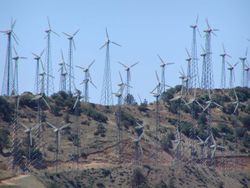
Tehachapi Pass Wind Farm
Encyclopedia
Wind development in the Tehachapi Pass
began in the early 1980s. The area hosts a multitude of wind farms, comprising one of California's largest wind resource areas. The pass is undergoing much repowering activity. The area has multiple generations of wind turbine technology installed, including both single and double blade turbines, as well as the more modern three blade horizontal axis design. The older generation turbines generate kilowatts, and the modern turbines installed generate up to 3 megawatts, depending on the specific turbine and manufacturer. The Tehachapi wind resource area is a net exporter of generation to other parts of the state of California. A state initiative to upgrade the transmission out of Tehachapi (Tehachapi Renewable Transmission Project) began in 2008 and is expected to be completed by 2012. This has opened the door to further regional wind power development and multiple projects are expected to be installed to utilize that capacity. A prime location for viewing the turbines is off of State Route 58
and from Tehachapi-Willow Springs Road.
One proponent for further regional wind power development is Southern California Edison
who executed power purchase agreements for up to 1,500 megawatts (MW) or more of power generated from new projects to be built in the Tehachapi area. The 2006 contract, which more than doubles SCE’s wind energy portfolio, envisions more than 50 square miles (129.5 km²) of wind parks in the Tehachapi region, which is triple the size of any existing U.S. wind farm.
Other well-known wind turbine locations in California include the Altamont Pass Wind Farm
and the San Gorgonio Pass Wind Farm
, near Palm Springs
.

Tehachapi Pass
Tehachapi Pass is a mountain pass crossing the Tehachapi Mountains in Kern County, California in the United States. The route over the pass connects the San Joaquin Valley to the Mojave Desert...
began in the early 1980s. The area hosts a multitude of wind farms, comprising one of California's largest wind resource areas. The pass is undergoing much repowering activity. The area has multiple generations of wind turbine technology installed, including both single and double blade turbines, as well as the more modern three blade horizontal axis design. The older generation turbines generate kilowatts, and the modern turbines installed generate up to 3 megawatts, depending on the specific turbine and manufacturer. The Tehachapi wind resource area is a net exporter of generation to other parts of the state of California. A state initiative to upgrade the transmission out of Tehachapi (Tehachapi Renewable Transmission Project) began in 2008 and is expected to be completed by 2012. This has opened the door to further regional wind power development and multiple projects are expected to be installed to utilize that capacity. A prime location for viewing the turbines is off of State Route 58
California State Route 58
State Route 58 is an east-west highway across the California Coast Ranges, the southern San Joaquin Valley, the Tehachapi Mountains, which border the southern Sierra Nevada, and the Mojave Desert. It runs between its western terminus near Santa Margarita and its eastern terminus at Barstow...
and from Tehachapi-Willow Springs Road.
One proponent for further regional wind power development is Southern California Edison
Southern California Edison
Southern California Edison , the largest subsidiary of Edison International , is the primary electricity supply company for much of Southern California, USA. It provides 14 million people with electricity...
who executed power purchase agreements for up to 1,500 megawatts (MW) or more of power generated from new projects to be built in the Tehachapi area. The 2006 contract, which more than doubles SCE’s wind energy portfolio, envisions more than 50 square miles (129.5 km²) of wind parks in the Tehachapi region, which is triple the size of any existing U.S. wind farm.
Other well-known wind turbine locations in California include the Altamont Pass Wind Farm
Altamont Pass Wind Farm
The Altamont Pass Wind Farm is located in the Altamont Pass of the Diablo Range in Central California. It is one of the earliest wind farms in the United States. The wind farm is composed of 4930 relatively small wind turbines of various types, making it at one time the largest farm in the world in...
and the San Gorgonio Pass Wind Farm
San Gorgonio Pass Wind Farm
The San Gorgonio Pass Wind Farm is a wind farm located on the eastern slope of the San Gorgonio Pass in Riverside County, just east of White Water, California, United States. Developed beginning in the 1980s, it is one of three major wind farms in California, along with those at Altamont and the...
, near Palm Springs
Palm Springs, California
Palm Springs is a desert city in Riverside County, California, within the Coachella Valley. It is located approximately 37 miles east of San Bernardino, 111 miles east of Los Angeles and 136 miles northeast of San Diego...
.

See also
- Wind power in the United StatesWind power in the United StatesAs of the third quarter of 2011, the cumulative installed capacity of wind power in the United States was 43,461 megawatts , making it second in the world, behind China. In 2010 wind power accounted for 2.3% of the electricity generated in the United States...
- Wind power in CaliforniaWind power in CaliforniaWind power in California has been an area of considerable activity for many years. California was the first U.S. state where large wind farms were developed, beginning in the early 1980s. By 1995, California produced 30 percent of the entire world's wind-generated electricity...

